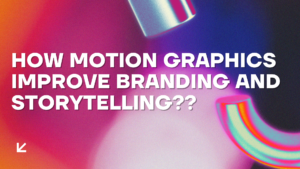In today’s digital landscape, where attention is shorter than ever, brands need innovative ideas to connect with their audiences. Motion graphics have emerged as a powerful tool for branding and storytelling, combining visual design with dynamic animation to create memorable and engaging content. Whether you are a marketer or a business owner exploring creative marketing strategies, understanding how motion graphics can elevate branding and storytelling is crucial for standing out in a competitive world.

This blog dives deep into what motion graphics are, why they matter, and how you can use them to tell your brand’s story effectively. By the end, you will see why motion graphics are more than just attractive—they are a game-changer for marketing.
What is Motion Graphics?
Motion graphics are animated graphic designs that bring static visuals to life using movement, sound, and often a narrative structure. It is not full-scale animations or live-action videos; motion graphics focus on the movement of design elements such as typography, shapes, and icons. These elements are animated to create engaging, often explanatory, content that can communicate ideas quickly and effectively.
Why They Matter: Motion graphics are particularly effective in a world dominated by digital platforms like Instagram, YouTube, or Twitter. They capture attention faster than static images and are more cost-effective than live-action videos.
Why Motion Graphics Are Vital for Branding and Storytelling
Storytelling is essential for any successful brand. It is how companies can connect with their audience on an emotional level, communicate their values, and inspire action. Here’s why motion graphics are a perfect medium for branding and storytelling:
- Simplify Complex Ideas Motion graphics make it easier to explain very complicated concepts by breaking them down into visual elements. For example, a tech company can use motion graphics to illustrate how their product works, making technical details accessible.
- Create Emotional Connections The combination of motion, sound, and color can evoke emotions in ways that static visuals or text alone cannot. Motion graphics can tell a story that connects with viewers, leaving an emotional impact on viewers.
- Enhance Brand Recall People remember visuals more effectively than text. By incorporating your brand’s colors, fonts, and logo into motion graphics, you can create a memorable experience that reinforces brand identity.
- Boost Engagement Videos—including motion graphics—generate higher engagement rates on social media compared to other content types. Engaged audiences are more likely to share, comment, and interact with your brand.
Step-by-Step Guide to Using Motion Graphics in Branding and Storytelling
Every great story starts with a clear narrative. Identify the core message you want to communicate. It will highlight your company’s mission, showcase your product, or celebrate a milestone.
Example:
A sustainable fashion brand might create a motion graphic that shows the journey of their products—from sourcing eco-friendly materials to reaching their customers.
Step 2: Develop a Script

A motion graphic without a script is like a movie without a plot. Write an engaging script that outlines what points you want to convey. Keep it simple and align it with your brand’s tone and voice.
Step 3: Create Storyboards

A storyboard is a visual representation of your motion graphic. It maps out how the sequence of animations, transitions, and visual elements helps in planning the flow.
Step 4: Creating Illustrations
- Create custom illustrations, icons, and characters based on the storyboard.
- Maintain brand consistency using colors, fonts, and styles that match the client’s identity.
Step 5: Animate Your Graphics
Once your storyboard is ready, start animating your elements. Use transitions, kinetic typography, and dynamic visuals to bring your story to life. Incorporate your brand’s colors, fonts, and logo to maintain consistency.
Step 6: Add Sound and Music

Sound enhances the emotional impact in your motion graphics. Use background music, voiceovers, and sound effects to complement the visuals and reinforce your message.
Step 7: Test and Optimize
Before publishing, test your motion graphic with a focus group or team to ensure it connects with your target audience. Make adjustments based on feedback and optimize for the platforms you will be using.
Tips for Maximizing the Impact of Motion Graphics
- Attention spans are limited, so aim for concise motion graphics that deliver your message within 30 to 60 seconds.
- High-quality visuals and animations are essential for maintaining credibility.
- Analyze your audience’s preferences and customize your motion graphics to their interests and behavior.
- Share your motion graphics across social media, websites, and email campaigns.
- Ensure that every element—from colors to typography—reflects your brand identity.
Real-World Examples of Motion Graphics in Branding and Storytelling
- Dropbox (IT): Their explainer videos use motion graphics to simplify their services, making them relatable and easy to understand.
- Airbnb (Online Marketplace): Motion graphics in their marketing campaigns showcase unique travel experiences.
- Nike (Shoe Brand): Dynamic animations highlight their products’ features while reinforcing their commitment to innovation and performance.
Key Takeaways
Motion graphics are more than just a trend; they are a strategic tool for enhancing branding and storytelling. By combining visuals, motion, and sound, by creating compelling narratives that capture attention. If you are ready to elevate your brand’s storytelling, now is the time to start exploring motion graphics. With the right tools and approach, you can transform your brand’s vision and leave an impression on your audience.
Ready to get started? At Digital Motion Academy, we offer comprehensive courses on motion graphics, equipping you with the skills to create stunning animations that captivate and inspire. Contact us today to learn more or enroll in our motion graphics program!
